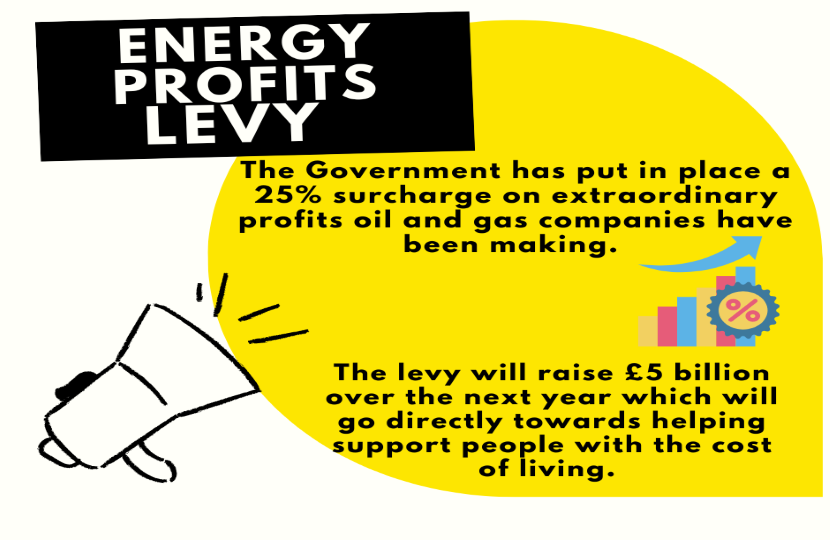
Following record high oil and gas prices over the past year due to global circumstances, and to help fund more cost-of-living support for UK families, the government has introduced the Energy Profits Levy, a new 25% surcharge on the extraordinary profits the oil and gas sector is making.
What has been introduced?
- Oil and gas prices have risen substantially, with oil prices nearly doubling since early last year, and gas prices more than doubling, resulting in significant increases in profits earned from UK oil and gas extraction.
- The new Energy Profits Levy will raise around £5 billion over the next year which will go towards supporting people with the new cost of living measures announced by the Chancellor.
- The government has also been clear that it wants to see the oil and gas sector reinvest its profits to support the economy, jobs, and the UK’s energy security.
- That’s why, within the levy, a new ‘super-deduction’ style relief is being introduced to encourage firms to invest in oil and gas extraction in the UK.
- The new 80% Investment Allowance will mean businesses will overall get a 91p tax saving for every £1 they invest – providing them with an additional, immediate incentive to invest. This nearly doubles the tax relief available and means the more investment a firm makes, the less tax they will pay.
- The levy does not apply to the electricity generation sector. However, certain parts of it have also seen extraordinary profits partly due to record gas prices. As set out in the Energy Security Strategy, the government is consulting with the power generation sector and investors to drive forward energy market reforms and ensure that the price paid for electricity is more reflective of the costs of production. Those reforms will take time to implement. In the meantime, the government will urgently evaluate the scale of these extraordinary profits and the appropriate steps to take.
- This will ensure a greater contribution from the most profitable companies. It is only fair that companies that have made genuine windfall profits as a result of the fallout of the war in Ukraine contribute more to fund the Government’s cost of living support.
How does the Energy Profits Levy work?
- Currently, the oil and gas sector pay a 40% headline rate tax on profits consisting of 30% Ring Fence Corporation Tax and 10% Supplementary Charge.
- In recent years, under the existing regime, fewer than 35 groups have made tax payments each year. In 2021, the top 7 groups accounted for around 95% of payments.
- The Energy Profits Levy is an additional 25% tax on UK oil and gas profits on top of the existing 40% headline rate of tax, taking the combined rate of tax on profits to 65%.
- To appropriately tax the extraordinary profits, companies will not be able to offset previous losses or decommissioning expenditure against profits subject to the levy.
- It is expected to raise around £5 billion in its first 12 months.
- The tax will take effect from today, 26 May 2022, and will be legislated for via a standalone Bill to be introduced shortly.
- In future years, if oil and gas prices return to historically more normal levels, the Government will phase out the Energy Profits Levy, and also the legislation will include a sunset clause, effective at the end of December 2025.
How does the new Investment Allowance work?
- The government has also been clear that it wants to see the oil and gas sector reinvest their profits to support the economy, jobs and the UK’s energy security.
- To encourage this, a ‘super-deduction’ style investment allowance will be introduced within the levy to provide an immediate incentive for the oil and gas sector to invest in UK extraction.
- The new investment allowance rate is 80% and means the total tax relief on investment nearly doubles - for every £1 businesses invest they will overall get a 91p tax saving.
- The current 10% Supplementary Charge provides companies with an investment allowance that can only be claimed once income is received from the field subject to the investment (which can take several years).
- In contrast, the new 80% Investment Allowance for the Energy Profits Levy will be available to companies at the point of investment, making it both more immediate and more generous.
- The government expects the combination of the levy and this investment allowance to lead to an overall increase in investment, and the OBR will take account of this policy in their next forecast.
Electricity Market Reform
- In the long term, the Government has launched a major review into Britain’s electricity market with the aim of reducing electricity costs and enhancing energy security.
- Potential changes to the wholesale electricity market would stop gas prices setting the price of electricity produced by renewables.
- You can find out more about this plan by following the link: https://www.gov.uk/government/news/uk-launches-biggest-electricity-market-reform-in-a-generation


